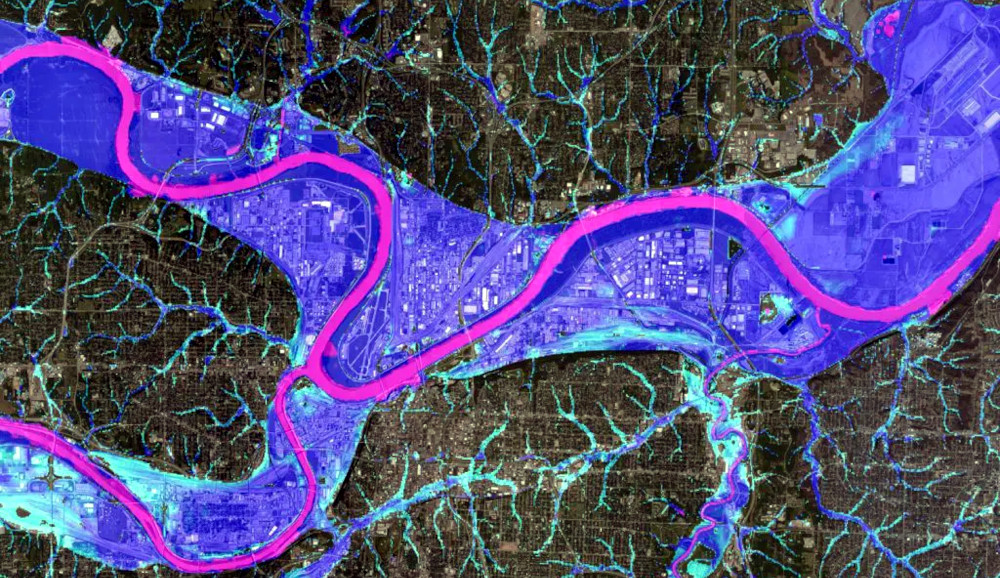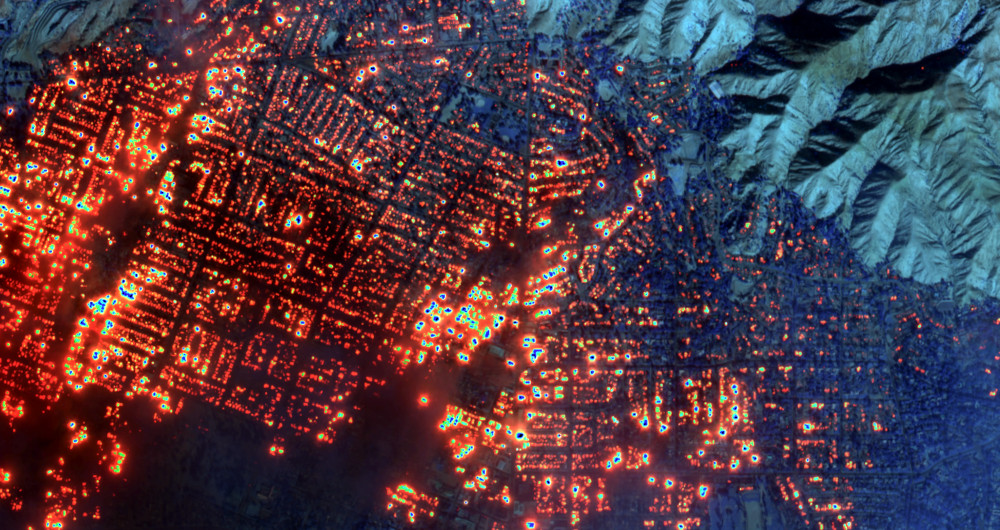Building new homes in disaster danger zones could cost billions, threaten affordability
 Image credit: Fathom
Global
Image credit: Fathom
Global
As is the case in most developed countries, governments across Canada are
racing to build more housing to improve affordability. Yet a new study from the
Canadian Climate
Institute
has found those efforts risk putting hundreds of thousands of homes in harm's
way — and adding billions of dollars in costs each year — unless policy is
improved to direct development away from the threat of wildfires and floods.
As Close to Home: How to build more housing in a changing
climate
outlines, building new homes in areas at a high risk of flood or wildfire could
cost governments, insurers and homeowners up to $3 billion more each year for
rebuilding and disaster relief. These risks are neither distant nor abstract:
Damages from just four extreme-weather events in July and August 2024 —
flooding
in Toronto and Southern Ontario, the catastrophic
wildfire
in Jasper, extreme
flooding
in Quebec and an historic
hailstorm
in Calgary — totaled more than $7 billion in insured
losses.
One of the most striking findings of the study is that most of the projected
costs are associated with a relatively small number of homes expected to be
built in flood-vulnerable zones: Redirecting just three percent of new homes
away from the highest-risk flood areas could save nearly 80 percent of all
projected weather-related losses by 2030.
"The most affordable home is the one you don't have to rebuild after a disaster.
Governments across Canada can save billions of dollars each year and keep people
safe from disasters by building just a small percentage of new homes away from
the highest-risk areas for wildfires and floods,” says Ryan
Ness, Director of Adaptation
at the Canadian Climate Institute. “Our new report outlines the tools
policymakers have to steer new housing to safer ground and support affordability
in the process."
The report — which includes wildfire-risk analysis from Canadian financial
services firm Co-operators, flood-risk modeling
by Fathom Global and future housing risk analysis
by SSG — is a first-of-its-kind analysis in Canada to model
the financial costs of future floods and fires on new housing slated for
construction by 2030.
It finds that more than 540,000 homes could be built in areas of flood hazard
and more than 220,000 homes in locations exposed to high wildfire hazards by
2030. The associated total costs are likely to be highest in British
Columbia — which faces $2.2 billion in added annual costs under a worst-case
scenario — followed by Manitoba ($360 million), Alberta ($220
million), and Quebec ($214 million). The Yukon could see increases in
average damages as high as $1,200 for each new home from flooding alone, well
beyond the national average.
The Climate Institute also commissioned a companion report, Indigenous
Housing and Climate
Resilience,
by Shared Value
Solutions
to identify unique challenges and barriers faced by Indigenous Nations in
developing climate-resilient homes, with a particular focus on housing on First
Nations reserves. The report examines successful policies and practices, and
presents nine policy recommendations.
"Solving Canada's housing crisis requires not just building more homes but
ensuring they're affordable in the long term. This includes building new homes
in safe locations that are resilient to increasingly severe floods and
wildfires,” asserts Lisa Raitt,
Vice-Chair of Global Investment Banking at
CIBC and Co-Chair of the Task Force for
Housing and Climate. “This new Climate Institute
report highlights the financial risks Canada faces if housing policy continues
to allow risky development, and offers actionable solutions to protect people
and property."
The report notes that all levels of government have a role to play in reducing
the threats of extreme weather disasters to new homes, and offers these policy
recommendations:
-
Federal, provincial and territorial governments should steer housing and
infrastructure investment away from high-hazard zones to low-hazard areas.
-
Provincial and territorial governments should strengthen land use policy to
redirect new construction away from areas at high risk of flood and fire
damage.
-
Federal, provincial and territorial governments should reform
disaster-assistance programs to deter risky development — for example, by
making new homes built in high-hazard zones ineligible for publicly funded
disaster compensation.
-
Governments should create, maintain and make publicly available maps that
show hazardous areas — and mandate the disclosure of such information in
real estate transactions — so that homeowners, renters and developers have
access to that knowledge.
-
The federal government should empower and support Indigenous communities to
build climate-resilient
homes
in safer areas within their territories.
"Local governments, at the forefront of both the climate and housing crises, are
essential partners in safeguarding Canadians and protecting communities from
escalating climate impacts,” says Carole
Saab, CEO of Federation of Canadian
Municipalities. “This report highlights the urgency of coordinating across all
orders of government and sectors to keep Canadians and their homes safe from
increasingly severe wildfires and floods."
Climate-driven migration, insurance increases could erase $1.4T in US real estate value by 2055
 The LA fires, January 2025 | Image credit: Maxar
The LA fires, January 2025 | Image credit: Maxar
Meanwhile, First Street’s just-released 12th
national report estimates a potential $1.47 trillion reduction in US real
estate value over the next 30 years due to climate-related risks.
First Street uses transparent, peer-reviewed methodologies to quantify the past,
present and future climate risk for properties globally and makes it available
for citizens, industry and government. In October, Zillow began offering
First Street’s data for five key climate-related
risks
on all for-sale property listings across the US — helping buyers to better
assess long-term affordability and plan for the future.
Drawing on interdisciplinary research that examines climate risk awareness,
housing market dynamics, climate migration patterns, and demographic and
socioeconomic shifts, First Street’s new Property Prices in
Peril report
offers a forward-looking analysis of the Housing Price
Index,
property-valuation trends and localized GDP impacts extending to 2055.
Key findings
-
By 2055, climate-driven weather phenomena are expected to increase homeowner
insurance premiums nationwide by an average of 29.4 percent — the five
largest metro areas facing the highest insurance premium increases are Miami
(322 percent), Jacksonville (226 percent), Tampa (213 percent), New Orleans
(196 percent), and Sacramento (137 percent).
-
Simultaneously, migration induced by climate risks including extreme heat,
wildfire and flooding is anticipated to drive significant population
redistribution, with 55 million Americans expected to relocate within the US
over the same period to historically less populous states such as North
Dakota and Montana — which are forecasted to grow due to their climate
resilience.
“Climate change is no longer a theoretical concern; it is a measurable force
reshaping real estate markets and regional economies across the United States,”
said Dr. Jeremy Porter, Head of
Climate Implications Research at First Street. “Our findings highlight the
urgent need to understand how rising insurance costs and population movements
are transforming the economic geography of the nation.”
The study projects a stark divergence in property values: High-risk areas are
likely to experience significant devaluation, while regions perceived as
climate resilient are
poised to benefit from increased demand. This reallocation of economic activity
will have profound implications for local government revenues — with at-risk
areas facing reductions in property tax income, while more resilient areas stand
to gain.
“These results highlight not only the pressing challenges but also the
opportunities for adaptation and
innovation
in the face of climate change,” added First Street founder and CEO Matthew
Eby. “Policymakers, businesses and
communities must act now to mitigate risks and capitalize on the emerging
economic opportunities in a shifting landscape.”
Get the latest insights, trends, and innovations to help position yourself at the forefront of sustainable business leadership—delivered straight to your inbox.
Sustainable Brands Staff
Published Feb 7, 2025 8am EST / 5am PST / 1pm GMT / 2pm CET